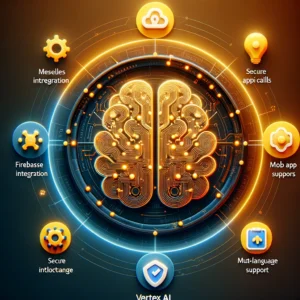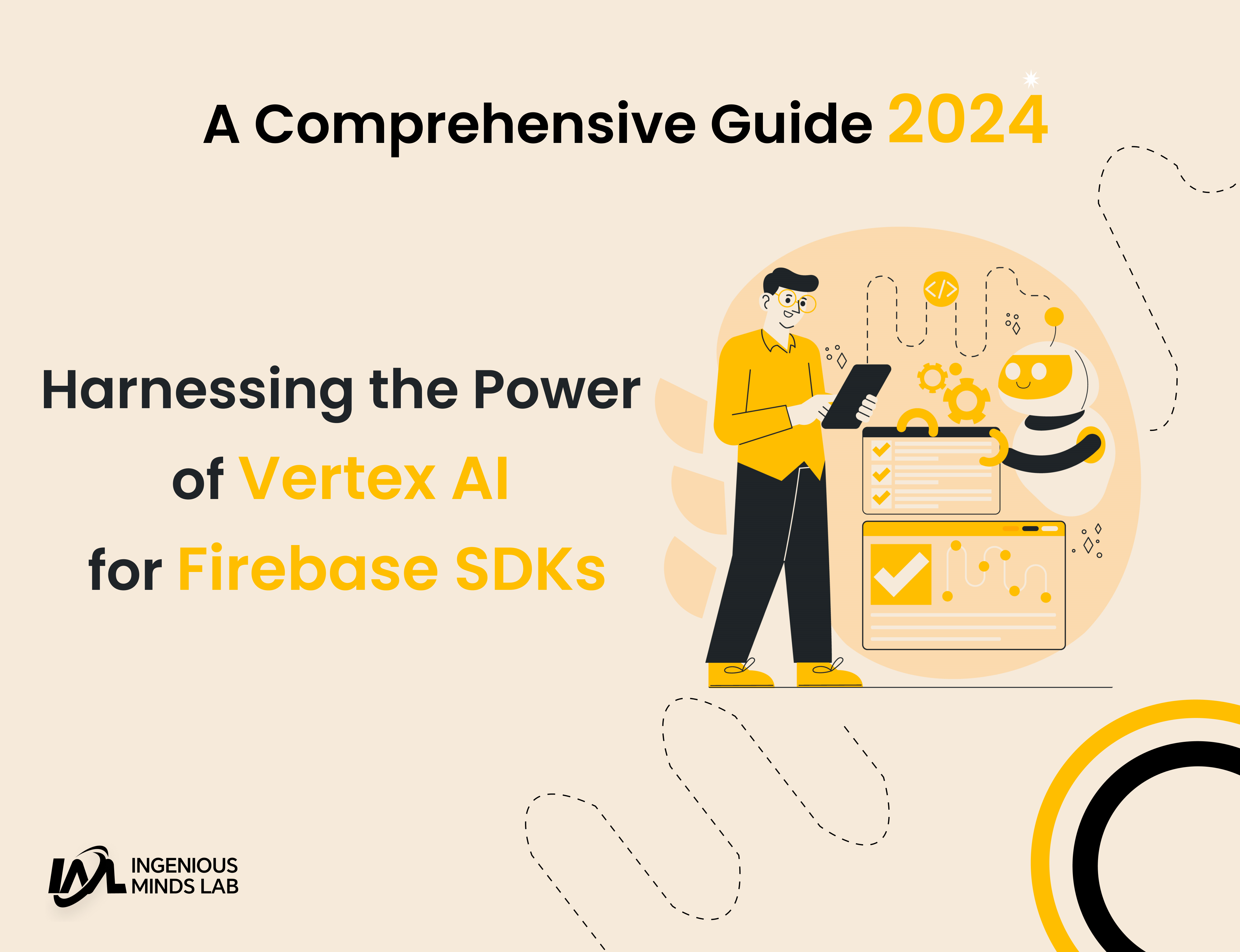In the ever-evolving landscape of mobile and web development, the integration of artificial intelligence (AI) is becoming increasingly crucial. Google has made a significant leap in this direction by introducing Vertex AI for Firebase SDKs. These SDKs enable developers to harness the power of Google’s Vertex AI directly within their Firebase-integrated mobile and web applications. This blog will explore the features, benefits, and practical applications of Vertex AI for Firebase SDKs.
What is Vertex AI?
Vertex AI is Google Cloud’s unified AI platform that simplifies the process of building, deploying, and scaling machine learning models. It provides a comprehensive suite of tools and services, including pre-trained models, custom model training, and deployment capabilities. By integrating Vertex AI with Firebase, developers can leverage advanced AI capabilities in their applications seamlessly.
Vertex AI offers a range of features such as AutoML for custom model building without extensive coding, pre-trained models for image recognition, text analysis, and more, along with tools for managing the entire machine learning lifecycle. Integrating Vertex AI for Firebase SDKs can significantly enhance your application’s capabilities, making it smarter and more responsive to user needs.
Introduction to Vertex AI for Firebase SDKs
The Vertex AI for Firebase SDKs allow developers to directly call AI models from their mobile and web apps. Available in popular programming languages such as Kotlin, Swift, Flutter, and JavaScript, these SDKs make it easier than ever to implement AI features within Firebase projects.
Key Features of Vertex AI for Firebase SDKs:
- Seamless Integration with Firebase: The Vertex AI for Firebase SDKs are designed to work seamlessly with Firebase services, ensuring that you can easily integrate AI capabilities into your existing Firebase projects.
- Secure API Calls: The Vertex AI for Firebase SDKs come integrated with Firebase App Check, which helps safeguard against threats like billing fraud, phishing, and app impersonation. This ensures that API calls are secure and originate from legitimate sources.
- Support for Multiple Languages: Whether you are developing for Android, iOS, or the web, Vertex AI for Firebase SDKs support multiple programming languages, making it versatile and accessible for various development environments.
- Pre-trained and Custom Models: Developers can use both pre-trained models provided by Google or deploy their custom-trained models. This flexibility allows for a wide range of AI applications, from natural language processing to computer vision.
- Ease of Use: The SDKs are designed to be user-friendly, allowing developers to quickly set up and start using AI models without extensive knowledge of machine learning.
- Scalability: Built on Google Cloud’s robust infrastructure, Vertex AI for Firebase SDKs ensure that your AI applications can scale effortlessly to handle growing user demands.
How to Get Started with Vertex AI for Firebase SDKs
Getting started with Vertex AI for Firebase SDKs involves several steps to ensure proper setup and integration. Here’s a detailed guide:
Step 1: Set Up Firebase and Vertex AI Before you can use Vertex AI in your Firebase project, ensure that you have both Firebase and Vertex AI set up. You can follow the official Firebase documentation for detailed setup instructions. Create a Firebase project in the Firebase Console and enable the necessary APIs in Google Cloud Console.
Step 2: Add Vertex AI for Firebase SDK to Your Project Add the appropriate SDK to your project. For example, if you are using Dart, you would add the dependency in your pubspec.yaml file:
dependencies:
firebase_core: latest_version
firebase_app_check: latest_version
vertex_ai: latest_version
Run flutter pub get to install the dependencies.
Step 3: Initialise Firebase and App Check
Initialise Firebase and App Check in your main file to ensure secure API calls:
import ‘package:flutter/material.dart’;
import ‘package:firebase_core/firebase_core.dart’;
import ‘package:firebase_app_check/firebase_app_check.dart’;void main() async {
WidgetsFlutterBinding.ensureInitialized();
await Firebase.initializeApp();
await FirebaseAppCheck.instance.activate();
runApp(MyApp());
}class MyApp extends StatelessWidget {
@override
Widget build(BuildContext context) {
return MaterialApp(
home: Scaffold(
appBar: AppBar(title: Text(‘Vertex AI with Firebase’)),
body: Center(child: Text(‘Hello, world!’)),
),
);
}
}
Step 4: Implement AI Features Using Vertex AI for Firebase SDKs
Now you can start using Vertex AI models in your app. For example, if you want to use a text classification model, you would set it up and call it as follows:
import ‘package:vertex_ai/vertex_ai.dart’;
Future<void> classifyText(String text) async {
final vertexAI = VertexAI.instance;
final result = await vertexAI.textClassification(text);
print(‘Classification result: ${result}’);
}
Practical Applications of Vertex AI for Firebase SDKs
The integration of Vertex AI for Firebase SDKs opens up numerous possibilities for enhancing your applications. Here are some practical applications:
1. Natural Language Processing: Use AI models to perform tasks like sentiment analysis, text classification, and entity recognition. This can enhance features such as chatbots, feedback analysis, and content moderation. For instance, integrating a sentiment analysis model can help businesses understand customer feedback in real-time and take appropriate actions.
2. Computer Vision: Implement image recognition, object detection, and facial recognition in your apps. These features are particularly useful in security applications, augmented reality, and visual search engines. For example, a retail app can use image recognition to help users find products by uploading a picture.
3. Recommendation Systems: Build personalized recommendation systems for e-commerce apps, streaming services, and social media platforms. By leveraging AI, you can enhance user experience and engagement. A personalized recommendation system can significantly boost user retention and increase sales by suggesting relevant products or content.
4. Predictive Analytics: Use AI models to analyze user behavior and predict future actions. This can be applied in various domains, including marketing, finance, and healthcare. Predictive analytics can help in identifying trends and making data-driven decisions to improve business outcomes.
5. Enhanced User Experience: Integrate conversational AI to create intuitive and responsive chatbots that can handle customer queries effectively. This can significantly improve customer satisfaction and engagement on your app or website. A well-designed chatbot can provide instant support, reducing the need for human intervention.
6. Real-time Data Analysis: Utilize AI to process and analyze data in real-time, providing insights that can help make informed decisions quickly. This is particularly useful for apps that require dynamic data handling, such as financial services or live event tracking. Real-time data analysis can help in monitoring and responding to critical events as they happen.
7. Personalized Content Delivery: Use machine learning models to analyze user preferences and deliver personalized content recommendations. This can boost user retention and interaction by providing a more tailored user experience. For example, a news app can deliver articles that match the user’s interests based on their reading history.
8. Automated Processes: Implement AI to automate repetitive tasks such as data entry, scheduling, and customer support. This can improve efficiency and free up resources to focus on more critical tasks. Automation can lead to significant cost savings and increased productivity.
9. Advanced Security Measures: Leverage AI for enhanced security features such as fraud detection, biometric authentication, and threat analysis. This can help in protecting user data and maintaining the integrity of your application. AI-based security measures can detect and respond to threats faster and more accurately than traditional methods.
Advanced Features and Best Practices
1. Using AutoML with Vertex AI for Firebase SDKs: AutoML allows you to train custom machine learning models with minimal coding. By using AutoML, you can create highly accurate models tailored to your specific needs. This feature is particularly useful for developers who may not have extensive experience with machine learning.
2. Managing the Machine Learning Lifecycle: Vertex AI provides tools for managing the entire machine learning lifecycle, from data preparation and model training to deployment and monitoring. Utilizing these tools can streamline your development process and ensure that your models are always performing optimally.
3. Integration with Other Google Cloud Services: Vertex AI for Firebase SDKs can be integrated with other Google Cloud services such as BigQuery, Cloud Storage, and Cloud Functions. This integration allows you to build comprehensive solutions that leverage the full power of Google Cloud’s ecosystem.
4. Implementing AI Ethics and Fairness: As AI becomes more prevalent, it’s crucial to consider ethical implications and ensure fairness in your models. Vertex AI provides tools and best practices for evaluating and mitigating bias in your models, helping you build responsible AI solutions.
5. Continuous Monitoring and Improvement: Once your AI models are deployed, it’s essential to continuously monitor their performance and make improvements as needed. Vertex AI for Firebase SDKs include features for tracking model performance and updating models to adapt to changing data patterns.
Conclusion
Vertex AI for Firebase SDKs provide a robust and secure way to integrate advanced AI capabilities into your mobile and web applications. By leveraging Vertex AI for Firebase SDKs, developers can build smarter, more intuitive apps that offer enhanced user experiences. Whether you are working on a small project or a large-scale application, Vertex AI for Firebase SDKs offer the tools and flexibility needed to bring your AI visions to life.

